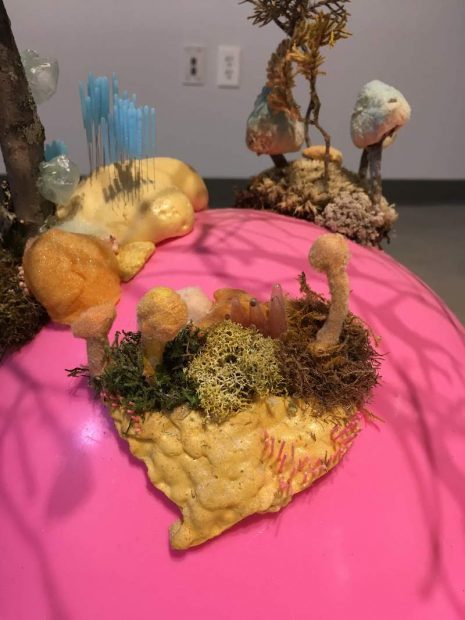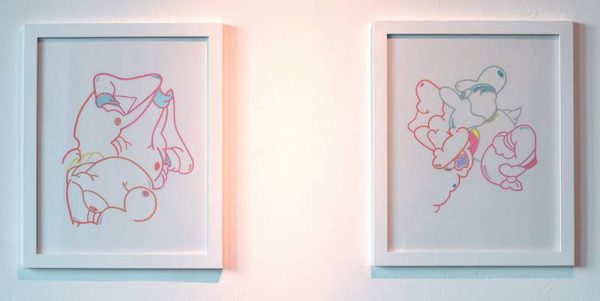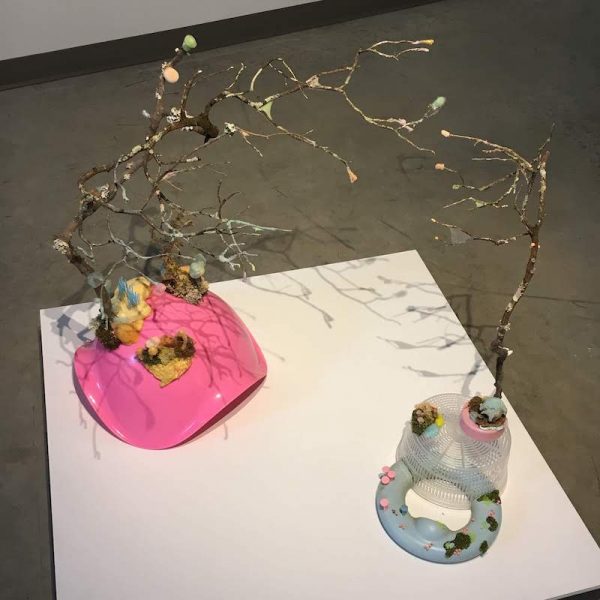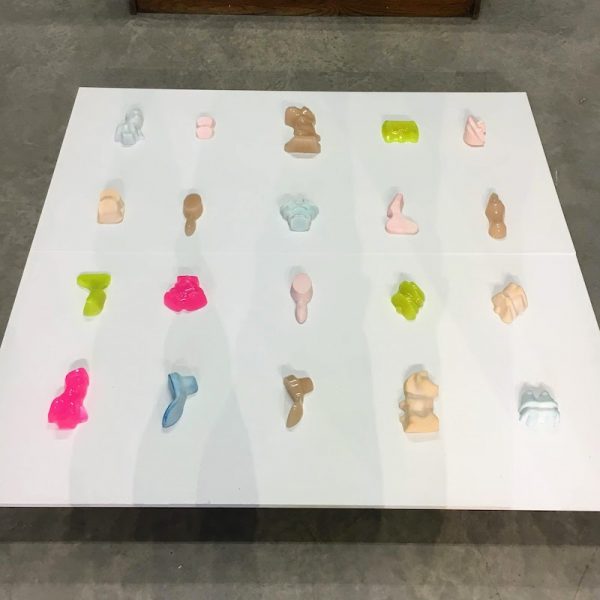Once a student of psychology, the artist and Tarleton State University professor Molly Valentine Dierks is interested in the fraught state of the human condition in a time of mass consumerism, technological mediation, and industrial production. Her solo exhibition at Texas Wesleyan University, Somewhere There is An Island, uses the language of mass entertainment, found materials (both manmade and natural), and suggestive ambiguity to explore the psychological space of human relationships in an interconnected world. The show is a loosely curated presentation of five bodies of work connected by a complex theoretical and metaphorical framework that centers on intimacy and alienation. Dierks undergirds each aesthetic decision she makes.
For all of this considered decision-making, however, most of these bodies of work come across as simultaneously experimental and overwrought. Having written that, I’m still glad I saw her work when and where I did. Choosing Dierks to launch the second exhibition season in the Bernice Coulter Templeton Art Studio is an ambitious choice for Texas Wesleyan. It’s a school that, as Kit Hall, the university’s gallery director and a professor of art, says, “…is a university full of tradition and traditional things.” The university’s visual art department is limited, but the gallery suggests the school’s desire to encourage students, faculty and the broader community to engage with thought-provoking contemporary art. I admire the choice to expose students to work that delves into a complex examination of contemporary consumer society, the psycho-sexual effects of technology, and the human impact on the natural environment.

Molly V. Dierks, Somewhere There is An Island (detail). Trees and found objects. Photo credit: Allison Klion.
Of these five bodies of work the most fully developed is series of assemblages made from tree branches arranged ikebana-like in over-turned plastic containers. These arrangements rest slightly off-kilter on three white platforms in pairs or threes, situated so that the branches reach toward each other with vaguely anthropomorphic tenderness. Each sculpture is further modified through the delicate application of industrially made materials sculpted to mimic natural growths: tissue-thin sanitary pad wrappers inflated like little puffball mushrooms; pale blue acupuncture needles that mimic a hairy fungus; tiny lime green crystals or stuffed animal hair coating the tips of branches; peachy fragments of medical gloves growing between branches. The artist clearly enjoys assembling these miniature worlds, and the details exude a sense of play and wonder. They’re promising, and I hope that the sculptures will continue to evolve to be more convincingly illusory and hallucinatory. I imagine a post-nature future for these plants — the artificial and organic co-evolving into a forest that pulses with electricity.

Molly V. Dierks, Left: Double-Take II. Laser-cut vinyl and felt. Right: Self-Help Tape. Laser-cut vinyl and felt. Photo c/o the Bernice Coulter Templeton Art Studio, Texas Wesleyan University.
The other groups of work in the exhibition are more straightforward attempts to give physical form to the alienating effects of mass consumerism and digital technologies in what Dierks calls the “ecology of interconnectedness.” They are playfully saucy, but not particularly provocative. In a series of collages using laser-cut vinyl and felt to delineate forms, Dierks flattens and deconstructs familiar Disney characters. By shifting and amplifying their bulbous proportions she reveals simmering sexual undertones. In some of the collages, recognizable characters like Goofy and Tigger are rendered into grotesque caricatures of their wholesome selves. In others, bodies are entwined in an exaggerated, amorous embrace. It isn’t clear where one character’s body ends and another begins; candy-colored lines suggest an orgy of limbs and organs appearing sex-like but never explicit. It’s as though these bodies don’t quite know what to do with each other — they’re vaguely erotic, but completely without intimacy.
Dierks is most effective at drawing attention to the deeply embedded sensuality of consumption in Digital Romance, a series of 20 resin-cast objects of ambiguous shape, arranged on a square platform on the floor in a regular grid. Rendered in saturated colors, they’re simultaneously evocative of broken plastic toys, Paleolithic Venus figures, and devices for personal pleasure. Cast in the interior voids of plastic blister packs from household products, they play on techniques of industrial production to reveal the underlying seductiveness of product design and our conflicted responses to it. The relief sculptures don’t provide much insight into the function of the product the packages once contained. Instead, they coyly invite the viewer to imagine some new function for these potential products. Digital Romance is the sharpest work in the exhibition, as it most directly speaks to the relationship between consumption and sexual desire without the extra weight of coded metaphor.
Overall, Dierks’s work is compelling, but there’s an unfinished quality holding it back from its full potential. Both the tree sculptures and the drawings reveal the artist’s labor and lack of mastery over her materials. Given her credentials and her attention to the underlying meaning of her material choices, this oversight seemed surprising. Still, I found myself thinking about her work and discussing it with everyone I could, and I look forward to seeing how she continues to refine her ideas.
Through September 13 at Texas Wesleyan University, Fort Worth





1 comment
i have admired molly’s work for years and noted the sensual over/undertones yet not quite finished product. i think she has never had the resources to really get into the development of her capabilities. if she had the freedom and not have to teach i think her development would let her do what she really wants to express.